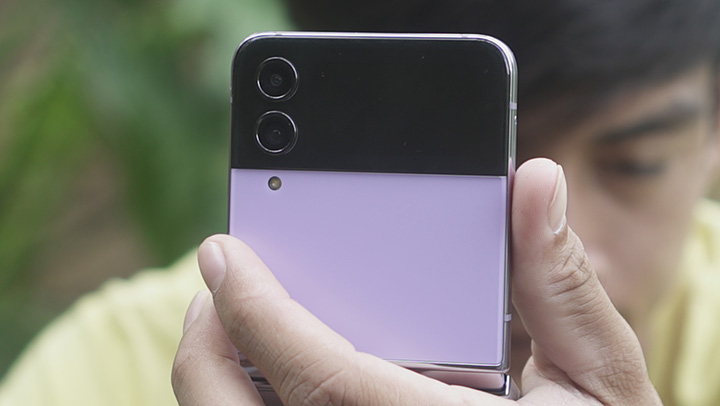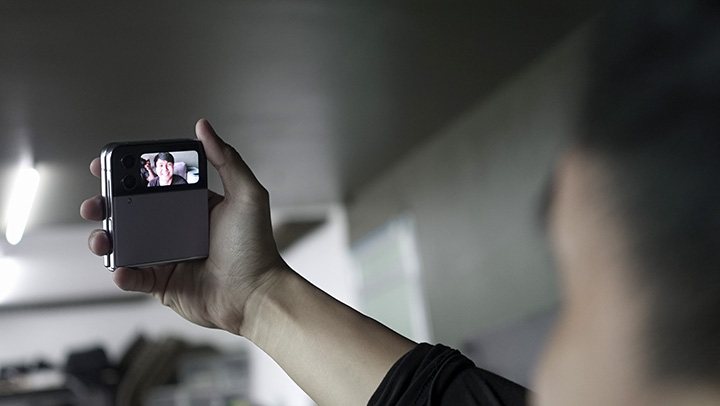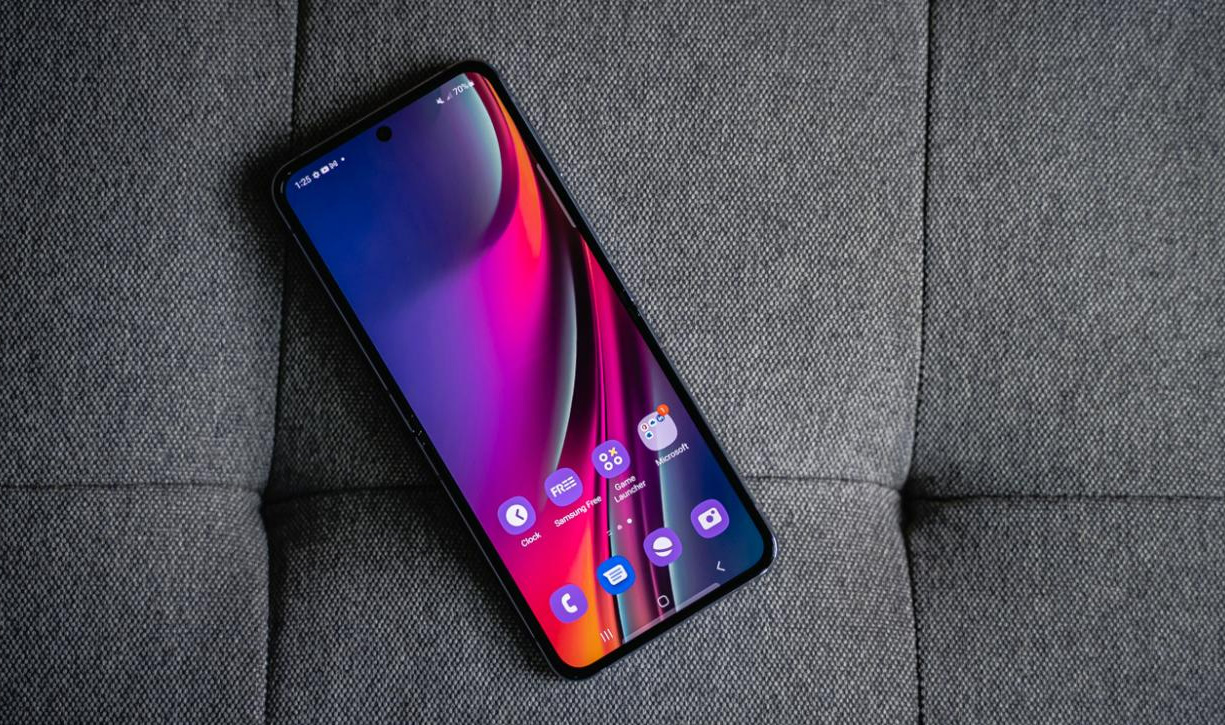Samsung has gone a long way since they first introduced their foldable phone about 4 years ago. It started out as a novelty but this time, the Korean company wants to make foldables a mainstream device. They hope the Galaxy Z Flip4 will get the crowd’s attention. Will it? Find out why in this full review.
Table of Contents
The flip form factor has been around for ages and Samsung is banking on its comeback with the Galaxy Z Flip4. It’s light and handy, easy to use with one hand, not buky at all unlike the Galaxy Z Fold4, and great form factor all-around.

Samsung has somewhat “perfected” the flip form factor so not much has changed between the Galaxy Z Flip3 and the new Z Flip 4 in terms of design. There’s very little difference in the dimensions of the devices (71.9 x 165.2 x 6.9mm) and the Flip4 is actually a little heavier (187 grams) than the Flip3 (183 grams).

Some of the minor refinements done to the Galaxy Z Flip4 include a slimmer hinge, straightened edges, contrasting hazed back glass and glossy metal frames. Aside from the hinge, we’d say all the rest of the changes done here are purely cosmetic in nature and it’s really up to personal taste.

Samsung also claims they’ve factory-tested the new hinge mechanism to last an average of 200,000 flips so you are guaranteed that it will last quite a long time before the mechanism wears off or breaks down.
The Galaxy Z Flip4 continues to have an IPX8 Rating for dust and water resistance of up to 1.5 meters in under 30 minutes. Also, note that this phone only comes with only one nano-SIM tray and no microSD card slot which could be a bummer for those wanting to expand storage and use a secondary line.
The main screen has a 6.7-inch full HD+ Dynamic AMOLED 2X Infinity Flex Display which is basically the same as its predecessor. The screen has a 2640x 1080 pixel resolution in a 22:9 aspect ratio and 120Hz adaptive refresh rate.

On the other hand, the Cover Screen still has a 1.9-inch Super AMOLED Display with a 260×512-pixel resolution and is protected by Gorilla Glass Victus+.
The inner display is still made with a combination of ultra-thin glass (UTG) and plastic in order to achieve a balance between durability and flexibility. There’s an initial layer of glass then topped with polycarbonate material which makes it look like glass but feels like a plastic screen protector. This is not as tough as the outer display and is more prone to scratches or creases, just like our previous experience with the Galaxy Z Flip3.
Our advice is not to over-abuse the inner display and of course, in time, you will eventually see the crease in the folded section which will become more prominent the longer you use it. That’s just the nature of foldable displays at the moment.

Despite all these, we’re still impressed with the quality of the display. Images are crisp with vivid colors, bright enough for the outdoors and very responsive with that 120Hz refresh rate. You won’t really notice any difference between this flexible display and the typical AMOLED display of other Samsung phones.

There’s a slight embossed border around the edges of the screen to help protect it if ever you drop the device face down and a set of small protruding rubber stoppers at the lower end to soften or cushion the impact of repeatedly flipping close the display.
The Galaxy Z Flip4 carries the same set of cameras as the Z Flip3, at least on paper. Samsung claims they’ve improved the low-light capabilities of the main cameras although we can’t seem to see the difference upon cursory inspection unless we do a side-by-side comparison here (we’ll see what we can do about that).

The main camera is a 12MP wide-angle, f/1.8 with 83-degree field-of-view while the secondary camera is another 12MP ultrawide angle, f/2.2 with 123-degree field-of-view.
Generally, photos looked good with vibrant colors, nice contrast and sharp but there’s nothing truly impressive in here. From experience, I would say we’re getting almost the same quality photos from the Z Flip4 and the Z Flip3.
Video quality is very good and can record up to 60fps in 4K. Here are some sample video clips from the rear camera:
The flip camera mode allows you to fold the device at 45-degree angle and shoot photos and videos with the first half of the screen as the camera display. It can be useful for shooting footages with one hand or when you want to do some livestreaming of video blogging.
Or you can place it half flat on the table and do a video call or Zoom call without needing any tripod or support which is very practical.

Up front is a 10MP selfie camera with f/2.4 and 80-degree field-of-view.
You can also shoot selfies using the main camera and frame the photo using the outer display or Cover Screen by double-tapping the power button.
Running the Galaxy Z Flip4 is Android 12 with One UI 4.1.1. It’s the familiar One UI of Samsung but this time they added some significant changes in the interface.
The Labs setting allows for experimental features like Multi window for all apps, Full screen in Split screen view, Swipe for pop-up view, Swipe for split screen and Flex mode panel.

The Cover Screen has also been expanded to include more usable features like video wallpapers and picture avatars, shortcuts to often-used settings and be able to reply to SMS and make calls straight away.
As for apps, the Flip4 came pre-installed with Samsung’s native apps like Samsung Free (free content like podcasts), Samsung Members (news and special offers), Samsung Global Goals which allows you to earn from ads, wallpapers and even while charging your phone and the money you earn can be donated to global goals to help poverty, education, gender equality, end hunger and sanitation. It’s actually a very nice initiative.
Samsung’s One UI is actually very clean and simple but has a lot of features and customizations under the hood. You could spend an entire day exploring all the options available to you and never run out of things to tinker around with.
The Galaxy Z Flip4 is powered by the latest Snapdragon 8+ Gen 1 chipset which is paired with 8GB of RAM. You have storage options of 128GB, 256GB and 512GB (online-only exclusive to Samsung.com) with the last item being the new option from its predecessor.

We tested the device across multiple synthetic benchmarks to see how it performs compared to other devices in its category, and against the Galaxy Z Flip3.
Antutu Benchmark: 819,637
Antutu Storage Test: 1,629MB/s (Sequential Read), 1,020MB/s (Sequential Write), 268MB/s & 215MB/s (Read, Write: Random Access)
Geekbench 5: 1,273 (Single Core), 3,199 (Multi Core)
3DMark: 2,755 (Wildlife Extreme Stress Test)
PCMark Work 3.0: 12,905

Synthetic benchmarks we’re not up to par with our expectations and even some of the scores we got here were a little lower than the ones with the Galaxy Z Flip3 (e.g. PCMark 3.0 and GeekBench 5). It could be either of two things — the chipset is throttled due to higher temperatures or there are still additional firmware updates that are coming to address this. We will definitely revisit this section once we get a definitive answer to this concern.

Nevertheless, we did not find any problems with the actual use of the device. It still feels fast and responsive, handled multiple apps quite well and performance in mobile gaming was all smooth.
As for connectivity, the device supports 5G, LTE, WiFi 802.11ac/ax and Bluetooth 5.2 with one nano SIM card and one eSIM support. Again, no microSD card support here and if you want to activate the eSIM, you’ll have to talk to your carrier for that.

The Flip4 now comes with 3,700mAh dual battery, a slight increase in capacity from the 3,300mAh of the Flip3. It’s still not that large compared to other conventional smartphones but still a welcome improvement. The foldable form-factor somewhat helps reduce battery usage since the 1.9-inch Cover Screen don’t eat up that much juice.
Super Fact Charging support is up to 25W which can do 50% charge in just 30 minutes. Samsung isn’t big with charging technology and some would say that 25W is a far cry from the 67W of other mid-range phones and the 120W of other flagship phones.

Based on PCMark Work 3.0 battery life test, the Flip4 got a score of 10 hours and 37 minutes on a full charge at 50% brightness, zero volume and in airplane mode. That is way better than the 7 hours and 49 minutes we got on the Flip3 for the same exact test.
Depending on where you are coming from, the Galaxy Z Flip4 might not be a huge jump from its predecessor. Very similar design, same display, almost identical camera, and RAM. On the other hand, it’s got the latest chipset, a bigger storage option, and a larger battery capacity. One can say this 4th generation seemed like an incremental upgrade only and there’s a bit of truth to that.

On the other hand, we can also surmise that Samsung’s foldable or flip phone has fully matured and nothing much can be done at this point but a little bit of incremental changes as what we’ve witnessed. There’s nothing much we can expect from that Infinity Flex Display in terms of material durability or even the eventuality of that crease being more prominent as you continue to use it every day.
But that’s not to say that the Galaxy Z Flip4 isn’t any good. On the contrary, it’s a beautiful flip phone and one of the best there is on the market today. Foldable phones are in another category altogether should not be compared with your typical flagship phones as there are technical challenges and limitations that come with the novelty. Nevertheless, they’re pretty close to the ideal.

In the past 4 years since its inception, they’ve come a long way. The Galaxy Z Flip4 is elegant, powerful, and fun to use. The Galaxy Z Flip3 was already good; what’s not to like with the Galaxy Z Flip4?
Samsung Galaxy Z Flip4 (SM-F721B) specs:
6.7-inch FHD+ (2640 x 1080 pixels) Dynamic AMOLED 2X, 120Hz refresh rate
1.9-inch 260×512 pixel AMOLED Cover Screen
Gorilla Glass Victus+ (outer display)
Armour Aluminum body
Qualcomm Snapdragon 8 Plus Gen 1
8GB LPDDR5 RAM
128GB, 256GB, 512GB storage
Rear camera: 12MP f/1.8 wide, 12MP f/2.2 ultrawide
Main Camera: 65% brighter pixel sensor
Enhanced OIS and VDIS
Front: 10MP f/2.4 wide
Dual nano SIM w/ e-SIM
5G, 4G LTE
WiFi 6e
Bluetooth 5.2
GPS, A-GPS, GLONASS, BDS, Galileo
NFC
USB-C
Fingerprint scanner
Face Unlock
IPX8 water and dust resistance
Android 12 with One UI 4.1
3,700mAh battery (50% in 30mins charging time)
25W wired charging and 15W wireless charging
The Samsung Galaxy Z Flip4 will be available for purchase starting September 2, 2022.
The Galaxy Z Flip4 128GB variant is priced at PHP 58,990USD 1,005INR 85,217EUR 957CNY 7,321, 256GB variant is PHP 62,990USD 1,073INR 90,995EUR 1,022CNY 7,817 and the online exclusive 512GB variant is priced at PHP 69,990USD 1,193INR 101,108EUR 1,136CNY 8,686.
Get up to PHP 29,800USD 508INR 43,049EUR 484CNY 3,698 worth of exclusive bundles if a customer pre-orders Galaxy Z Flip4 through Samsung’s official Online Store. The exclusive bundle is composed of a Super Fast Wireless Charger Duo, Clear Slim Cover, a discount voucher of 50% off on Galaxy Buds2 Pro and 30% off on Galaxy Watch5 Series, and 1 full year of Samsung Care +.

YugaTech.com is the largest and longest-running technology site in the Philippines. Originally established in October 2002, the site was transformed into a full-fledged technology platform in 2005.
How to transfer, withdraw money from PayPal to GCash
Prices of Starlink satellite in the Philippines
Install Google GBox to Huawei smartphones
Pag-IBIG MP2 online application
How to check PhilHealth contributions online
How to find your SIM card serial number
Globe, PLDT, Converge, Sky: Unli fiber internet plans compared
10 biggest games in the Google Play Store
LTO periodic medical exam for 10-year licenses
Netflix codes to unlock hidden TV shows, movies
Apple, Asus, Cherry Mobile, Huawei, LG, Nokia, Oppo, Samsung, Sony, Vivo, Xiaomi, Lenovo, Infinix Mobile, Pocophone, Honor, iPhone, OnePlus, Tecno, Realme, HTC, Gionee, Kata, IQ00, Redmi, Razer, CloudFone, Motorola, Panasonic, TCL, Wiko
Best Android smartphones between PHP 20,000 - 25,000
Smartphones under PHP 10,000 in the Philippines
Smartphones under PHP 12K Philippines
Best smartphones for kids under PHP 7,000
Smartphones under PHP 15,000 in the Philippines
Best Android smartphones between PHP 15,000 - 20,000
Smartphones under PHP 20,000 in the Philippines
Most affordable 5G phones in the Philippines under PHP 20K
5G smartphones in the Philippines under PHP 16K
Smartphone pricelist Philippines 2024
Smartphone pricelist Philippines 2023
Smartphone pricelist Philippines 2022
Smartphone pricelist Philippines 2021
Smartphone pricelist Philippines 2020
Yugo says:
I’ll buy one tomorrow. It’s nice to have a page like Yugatech! Thank you